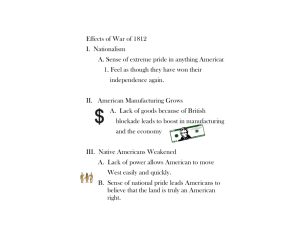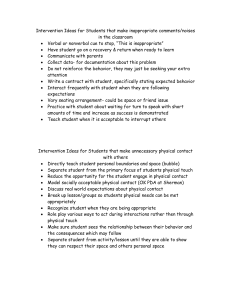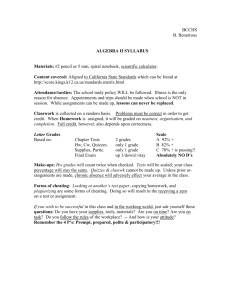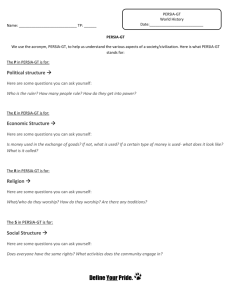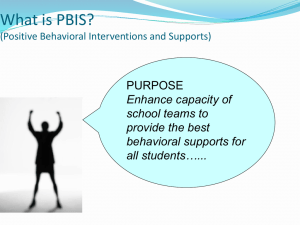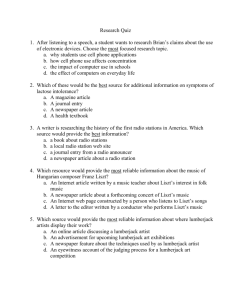Heyburn Behavior Plan
advertisement
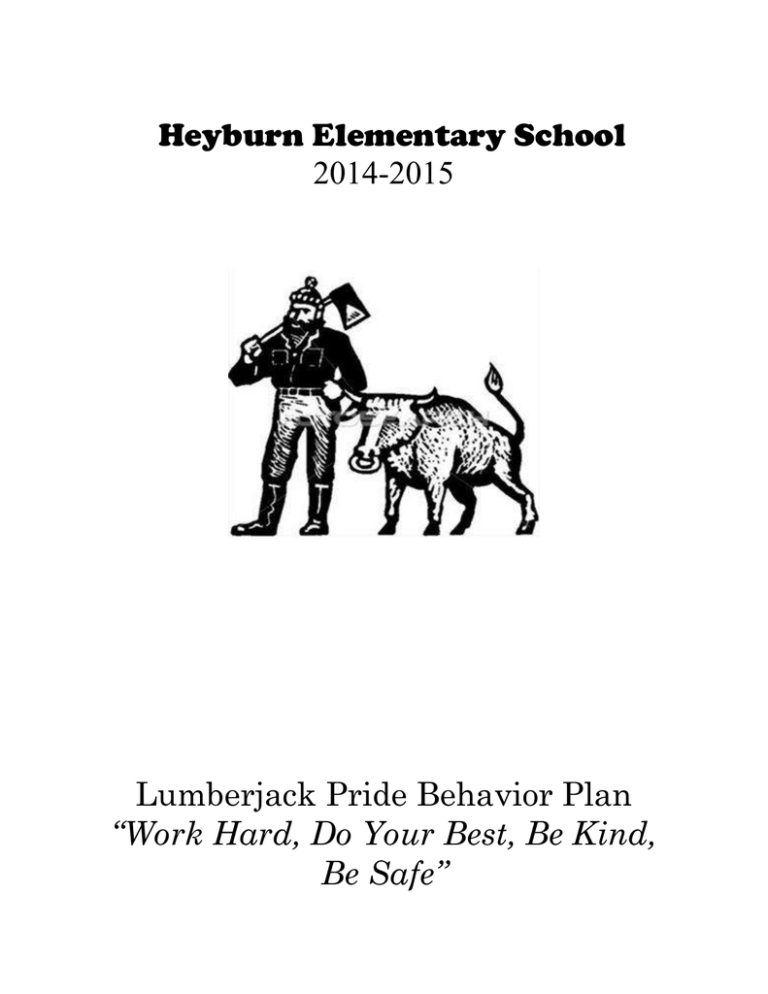
Heyburn Elementary School 2014-2015 Lumberjack Pride Behavior Plan “Work Hard, Do Your Best, Be Kind, Be Safe” Dear Parents; I want to take some time to describe our school wide behavior plan. We believe that this plan reinforces our philosophy of providing a positive learning environment which maximizes instructional time for all of our students. We believe that our behavior program will foster an environment of kindness and mutual respect that is conducive to learning where teachers can teach and students can learn. Our plan is called the “Lumberjack Pride” Behavior Plan since each day we remind our students to show their Lumberjack Pride by working hard, doing their best being kind and being safe. We are taking time during the first month of school to teach this plan to our students. We formally began the program on the first day of school. In order to keep our program consistent across all grade levels, we will be implementing a school-wide Discipline Curriculum called PBIS in grades K-5th, which is based on fair and positive interactions with students and teachers. Research has indicated that parental involvement is essential for any behavior plan to be effective. Our school mission statement is “Children of today…Leaders of tomorrow.” We believe that by working together, we can more effectively help our students to be successful, learn to their fullest potential and have Lumberjack Pride each and every day. In order to make certain that all parents have a copy of the plan, we ask that you sign the insert and return it to your child’s teacher. Please review and discuss our school Behavior Plan with your child. Let us know if you have any questions, comments or concerns. Sincerely, Staci Truscott, Principal I. Lumberjack Pride School Wide Focus (Board Policy 502.2) At Heyburn Elementary School, we believe that every student and staff member has the right to be in a school environment where he/she feels safe, respected, and protected. To ensure this, we focus on Working Hard, Doing Your Best, Being Kind and Safeeach day. We will work to raise our students’ awareness about which types of behavior are respectful and which are inappropriate or show disrespect. Students should strive to do their best and be their best while at school. We ask that students show respect at all times while at school. This includes to/from school, at the bus stop, on the bus, in the hallways, during lunch, while at recess, on field trips, during assemblies, and while in class. II. SHOWING LUMBERJACK PRIDE IN THE CLASSROOM Our objective and intent is to ensure that all students are safe, comfortable, and are not being distracted from learning while at school. III. SHOWING LUMBERJACK PRIDE THROUGHOUT THE SCHOOL On the Bus - Please talk to your child about proper behavior on the school bus. Students should stay in their seats, keep hands to themselves, maintain safe behavior at bus stop, not run in street, and never throw objects. There are additional bus rules in the Code of Behavior. If students cannot conduct themselves appropriately while on the bus, they may be suspended from the bus. Bus riding is a privilege. In the Cafeteria - We expect students to have good manners in the cafeteria. School rules also apply in the cafeteria. Students should use polite manners, remain seated, walk at all times, sit at assigned tables, and raise their hands. Students who break cafeteria rules or disturb others may be sent to the quiet table where they will remain to eat the rest of their lunch in quiet. We will explain our cafeteria behavior plan to the students. In the Hallways - The hallway is considered a Quiet Zone. Students are expected to be quiet while walking or waiting in the hallway so that they do not disturb students in other classes. In the Restroom - Students should be respectful of one another and school property while using the restroom. No horseplay or vandalism is permitted. Students should be quiet and respect the privacy of others. The restroom is not a play area and is not to be used for social gatherings. On the Playground - Students should continue to remember their Lumberjack Pride while at recess. In addition, students should remember that recess should be a fun time. It is important that students play fair and not roughly with other students. Inappropriate words, actions and behavior will not be tolerated outside the building just as they would not be tolerated in the building. Walking Home – Students should demonstrate Lumberjack Pride while walking to and from school each day. IV. CHARACTER COUNTS The teaching of character education in Idaho public schools became mandatory and the Idaho State Board of Education approved criteria for character education. Character traits as defined in the Code of Idaho include: 1. Trustworthiness: including honesty, integrity, reliability, and loyalty. 2. Respect: including the precepts of the Golden Rule, tolerance, and courtesy; 3. Responsibility, including hard work, economic self-reliance, accountability, diligence, perseverance, and self-control. 4. Fairness: including justice, consequences of bad behavior, principals of nondiscrimination, and freedom from prejudice. 5. Caring: including kindness, empathy, compassion, consideration, generosity, and charity. 6. Citizenship: including patriotism, the Pledge of Allegiance, respect for the American flag, concern for the common good, respect for authority and the law, and communitymindedness. It has become imperative that, as educators, we nourish and cultivate the emotional and social development of our students as well as their academic development. We are faced daily with compelling evidence and information, through news reports, educational statistics, and our own awareness of the changing fabric of society, which emphasizes the need for character education programs within schools. By incorporating these skills, ideas and activities into our students’ educational program, we feel there will also be an increase of student academic success. Students will understand their role and responsibility in their education as well as the education of others and see the value and strengths that they and others possess. V. BULLYING BEHAVIOR At Heyburn, we will not tolerate Bullying Behavior and have a No Bullying Policy (Board Policy 502.14). Many of the behaviors that we witness between students can be classified as bully types of behavior. We want our students to feel safe and comfortable at school so they can be focused on learning to their fullest potential every day. We have identified the following behaviors as bullying behavior: pushing, hitting, kicking, pulling, hurting, slapping, inappropriately touching, spitting, stealing, destroying property, gossiping, spreading rumors, embarrassing others, ethnic slurs, name calling, taunting, humiliating, excluding from group, dirty and hurtful looks and gestures, putdowns, teasing, telling others you won’t be their friend, threatening, intimidating, harassing, pressuring or making others do things they don’t want to do, writing unflattering letters, notes, stories or emails about others, and drawing unflattering pictures of others. VI. INAPPROPRIATE BEHAVIORS AND CONSEQUENCES We believe an effective discipline plan must provide instruction to students indicating which behaviors should be avoided. It is important that all of our students learn to accept responsibility for their actions and understand that there are consequences for inappropriate behaviors. We believe that most discipline situations can be resolved in the classroom with the help of teachers, students and parents. However, if a problem continues, it will be necessary to send the student to the office with a discipline referral. We also recognize that some students may need an individual behavior plan. The administration, guidance counselor, teachers, parents, and students will develop these, if necessary. We have identified and divided inappropriate behaviors below in increasingly serious levels in order to more effectively help students understand which actions are not appropriate for school. Minor Name-calling/teasing Embarrassing others Pictures/notes during instruction Disruptive behavior in the classroom Inappropriate running Disregarding/ignoring requests Interrupting during lessons Excessive talking Not following directions/Off task Incomplete/missing home/class work Vulgarities - Something said in poor taste. Careless use of property Moderate Inappropriate gestures/body language Put downs/insults/degrading remarks Back talk/muttering under breath Defiance/Arguing with teacher Lying Profanity Cheating Pulling on others/putting hands on each other Possession of inappropriate material Disruptive behavior that endangers property Major Hitting/kicking/slapping/pinching/ Hair pulling Spitting/ pushing Throwing things Stealing Obscene language/gesture/Ethnic slur Harassing/bullying behavior/Repeated Verbal assault Threatening others Disruptive behavior that endangers others Fighting Vandalism/damaging property Graffiti—using a permanent medium on school property Inappropriate touching Drugs/weapons Below is a list of possible consequences. Teacher/student conference Classroom time out (Refocus) allows the student to reflect on behavior and think about better choices. Writing Sentences Loss of recess time Teacher/Parent conference/phone call Review definition and rule Refer student to school counselor Student writes note to parent acknowledging the inappropriate behavior to be signed by a parent Lunch in office Detention—after school Loss of field trips, assemblies and other special events In-school/Out of school suspension (Board Policy 502.2) DETENTION We have an after school detention program. Teachers and administrators can assign students to detention. Detention is designed to help students think and reflect about their behavior. There will be assignments related to the Code of Behavior, Character Counts, and our Discipline Plan. Detention may be assigned if a classroom discipline situation continues to exist. It may also be a consequence for a major infraction. Detention could also be assigned to help correct a bus or lunch problem or for incomplete or missing homework. Parents will be contacted by phone. Parents will pick up their child at the conclusion of detention. VII. SPECIAL NOTE TO PARENTS AND STUDENTS 1. Verbal threats or comments of physical harm/injury by one student to another will not be tolerated at any grade level. Depending on the nature of the incident, out of school suspension and police contact are possible. This is not a joking or teasing matter. 2. Any verbal threats or comments about harming the school or school property will not be tolerated. Depending on the nature of the incident, out of school suspension and police contact are possibilities. Again, this is not a joking or teasing matter. Please remind your child to tell an adult if he/she is being teased or being called names. We can solve the situation but we need to know. 3. Bullying, Hazing, Harassment, Sexual Harassment, Intimidation, or Menacing Behavior of any kind will not be tolerated. COMPLAINT PROCEDURES Building principals and the Superintendent have responsibility for investigations concerning hazing, harassment, intimidation, bullying or menacing. The investigator(s) shall be a neutral party having had no involvement in the complaint presented. Any student, employee or third party who has knowledge of conduct in violation of this Policy or feels he/she has been a victim of hazing, harassment, intimidation, bullying, cyber bullying or menacing in violation of this Policy shall immediately report his/her concerns. Harassment Complaint Form can be located in Policy 502.14 at www.sd41.org. 4. The Code of Behavior (Board Policy 502.2) outlines provisions regarding weapons. This also applies to toy weapons. If a student accidentally brings something to school that he/she realizes should not be at school, the student needs to tell an adult as soon as possible. 5. We will be reinforcing these points when we meet with students. 6. Disruptive incident/Teacher removal of student from class—occasionally, it may be necessary to remove a disruptive child from the classroom. The following procedures are to be followed: A student may be removed from the classroom if his conduct obstructs the learning environment or if he is exhibiting behaviors that are considered harmful to himself, to the teacher, or to other students. If a student is exhibiting inappropriate behavior, a teacher has the option of escorting the student to the office, or of calling the office and asking for someone to come and remove the student. The student will be allowed to return to the classroom only after the administrator and the teacher have conferred and a joint decision has been reached as to when the student may return. There may be some instances in which an administrator is not available to deal with the referral. In those cases the guidance counselor will talk with the student. The student may be returned to class until an administrator is available. If the student’s behavior escalates, the parents will be called and asked to come to school to meet with an administrator and possibly take the child home. The counselor and teacher may be in attendance at this meeting. If a student receives three such discipline referrals he will be recommended for Out Of School Suspension. An administrator and the teacher will determine the length of the suspension. VIII. POSITIVE RECOGNITION At Heyburn Elementary School, we believe all students, staff and parents should feel safe, comfortable and respected. We are all committed to providing the most effective learning environment possible and maximizing instructional time for all students. We want our students to learn, be successful, and feel happy while at school. Our teachers and staff will provide positive reinforcement through individual classroom recognition activities as well as school-wide programs. The administration will also recognize students for their outstanding work, behavior, effort, and attitude. Please keep us informed of your child’s achievements and successes outside of school. In addition to classroom reward systems, we will recognize students as a whole school in a number of ways as outlined below. Citizenship and Positive Behavior Recognition Classroom Recognition Plans – Each classroom has a plan in place to recognize students during the school day. Your classroom teacher will share their plan with their students and you. Caught in the Act – Heyburn Staff will select students who they feel has made a positive difference in the school environment, has shown outstanding character and has been a good worker. Whenever a child receives a ticket, they may write their name on it and take it to the office. They will then put the ticket in a special container, and will be entered into a drawing for a Bud’s Burger Coupon. The more tickets they have in the jar, the better the chance that they will be drawn. When a ticket is placed in the jar, students will receive a certificate to bring home. Chopper Award – Students who exhibit excellent school-wide behavior for an entire month will be recognized at a monthly awards ceremony and be added to the Chopper Wall of Fame. Student of the Month Attendance Recognition Perfect Attendance pencils – Grades K-5 - Every 9 weeks, these pencils will be given to students who have attended school each day and have no more than 2 tardies or early dismissals. Excellent Attendance pencils– Grades K-5 - Every 9 weeks, these pencils will be given to students who have attended school each day and missed no more than 1 day of school and have no more than 2 tardies/ early dismissals. Academic Awards Straight A Honor Roll Certificates – Grades 4-5 - All A’s in all Academic Subjects. Honor Roll Certificates – Grades 4-5 -A’s and B’s in all Academic Subjects. Heyburn Lumberjack Award – Grades K-5 for 2nd – 4th Marking Period --Given to students who have brought up a grade in one subject area while maintaining their grades in their other subjects. End of the Year Recognition Straight A Honor Roll All Year Certificates – Grades 4-5 - Given to students who have had all A’s in all academic subjects for the entire school year Honor Roll All Year Certificates – Grades 4-5 - Given to students who have had all A’s and B’s in all academic subjects for the entire school year. Perfect Attendance All Year Certificates – Grades K-5 - Given to students who have attended school each day and have no more that 5 tardies for the entire school year. Excellent Attendance All Year Certificates– Grades K-5 - Given to students who have missed no more than 2 days of school and have had no more than 5 tardies for the entire school year. Chopper Award – All Chopper Award recipients will be entered into a prize drawing. Other Types of School Wide Recognition Birthday Recognition – Students will be recognized on their birthdays or during the school year for summer birthdays by the teachers/administration. Brag Notes - Parents are encouraged to send to us brag notes about their child’s accomplishments that we can share on the “We are in the News” bulletin board or the daily announcements. These can be written on any type of notepaper to be sent to the office. The notes will be shared in the announcements during the week. --------------------------------------------------------------------------------------------------------------------- Please return to your child’s teacher by September 5, 2014. Thank you I have received and reviewed the Heyburn Lumberjack Pride Behavior Plan. Parent Signature:___________________________________________ Student’s Signature:________________________________________ Teacher’s Name:___________________________________________ Positive Recognition…Our Brag Note Tell your child’s teacher something special about your child and we will announce it with our morning announcements. Student Name Brag: Teacher:
